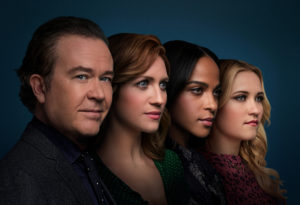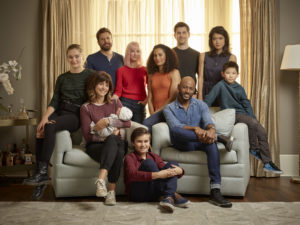On an October day in 2016, Adrian Jones set out on what was for him a common pastime — a strenuous mountain bike ride with friends. Midway up a steep grade, Jones — who by all appearances was fit and healthy — began experiencing alarming symptoms including extreme fatigue, nausea, lightheadedness, and, ultimately, chest pain. His friends rushed him to Marin General Hospital, oddly the same place where the adoptee had been born almost 47 years earlier. There, he was diagnosed as having had a “widowmaker” heart attack, his left anterior descending artery having been 100% occluded.
Grateful to have survived this typically lethal heart condition, Jones heeded a voice he heard when he was in the ICU. It said, “Find your birth parents!” With the help of a genetic genealogist, he did, and he discovered that heart disease runs — gallops — in his family, having killed an uncle at age 52 and both of his maternal grandparents, his grandmother at 65 and his grandfather at 71.
Jones’ story illustrates why having a family medical history is essential. Had he known what he now knows, he would have been able to undergo appropriate screening and might have been able to detect a problem before it had the potential to become lethal.
Although many of us are blocked at every turn when trying to gather information about our inherited health risks, continuing to do everything possible to obtain such information — including advocating for the right to have it — is crucial. But until you’re able to know more about the potential issues that may be a part of your family’s legacy, DNA testing may be the only path you can take to improve your awareness of your genetic risks and minimize them.For most humans, the bulk of our DNA is sequenced similarly. A small percent of our DNA — roughly 0.5% — differs. Within that 0.5% are the genes that influence our risks for various health conditions and diseases. Though knowledge of DNA sequencing and the human genome in general has advanced tremendously, making it possible to detect vulnerability to many heritable diseases, there remains much that’s unknown. Thus, while DNA testing can help indicate possible health risks, at worst it’s imprecise and can be misinterpreted and at best it doesn’t provide the full picture. Understand going into it that it won’t give you a road map to your future health, nor will it diagnose disease. But it may permit early detection of diseases and in some cases can be a lifesaver.Although there are now many companies that offer direct-to-consumer (DTC) DNA tests, the best known of these, 23andMe, was the first to receive FDA approval to market tests providing information about genes influencing health and disease. Recently, another of the leading genealogical testing companies, MyHeritage, has begun offering a health test. The tests look for genetic variants called single nucleotide polymorphisms (SNPs) that are associated with risk for developing a number of diseases, including Parkinson’s disease, age-related macular degeneration, early-onset Alzheimer’s disease, and breast cancer. They also show whether you have a genetic variant (once known as a mutation) that may contribute to diseases you can pass on to your children, such as sickle cell anemia or cystic fibrosis. If you have one copy of a gene variant associated with a condition, you are a carrier. A child whose parents both have that variant will develop that genetic disorder.
But these tests don’t tell the whole story and don’t examine all genes that influence disease risk.
Before selecting one of these tests, especially when considering one from a lesser-known business, research the company’s track record, look at the credentials of the team, and ensure that you’ll have access to representatives who will answer all your questions. Look for guidelines about choosing a DTC test from the National Institutes of Health’s National Library of Medicine.If you’ve taken an autosomal DNA test for genealogical purposes, you can download your raw DNA file, which contains a sampling of your DNA. Then you can download that information to any of a number of services, such as Promethease, LiveWello, or Sequencing, that will use that raw data to generate health reports, in many cases involving many more conditions and risks than those addressed by the major DTC tests and in far greater detail. The results, however, can be both bewildering and anxiety-provoking. I’ve uploaded my DNA to each of these companies and, despite having been a health journalist for many years, I find the reports both difficult to understand and somewhat alarming. Even if you have a science background as well as the time and motivation to learn to how to interpret the findings, you may believe you understand the results, but it’s likely that without the assistance of a genetic counselor you may misinterpret the findings, and the consequences can be serious.
In addition to these third-party tools, new programs and apps are appearing almost daily that purport to tell you how to best eat, exercise, sleep, and even age based on your DNA. These may offer results pertaining to such traits as metabolism, muscle strength, sleep, and nutrient absorption. They may be interesting and entertaining, but their science base is questionable and they’re of little use if you’re looking to fill in the gaps of your knowledge about health risks. And as with everything, it’s a question of buyer beware. It’s a caveat that’s especially important when these companies also aim to sell you supplements, programs, or other products they claim are individualized to your specific needs as indicated by your genes. The evidence for the effectiveness of the DNA analysis and of the associated programs and products in many if not most cases is lacking.All of these DTC approaches have benefits and limitations, the former being chiefly that they’re simple, noninvasive tests that may allow you to become aware of health risks before a condition develops and to take preventive measures or they may point to existing conditions and lead you toward prompt treatment. They generally are less expensive than medical-grade tests and typically do not require recommendation by a physician. However, the gap is closing, with some newer, more affordable medical-grade options, such as tests by Invitae, Color Genomics, and some of the Helix tests, says Kirkpatrick.
Sadly, the list of the limitations of DTC testing is much longer:
Genes are only part of the picture. Just because a condition may run in your family doesn’t mean it’s truly all in your genes. Your genetic inheritance is just one component of disease risk. Also influencing your risk are your environment, your lifestyle choices, and the interplay of multiple genes. Moreover, although your genes don’t change with time, the knowledge about them and available testing options do. “Most genetic variants that are associated with disease are actually not predictive, meaning we can test for a condition but it doesn’t mean that condition is going to develop because there’s a lot more complexity to disease development,” says Kirkpatrick. A condition such as type 2 diabetes, for example, “takes more than 1,000 different markers and environmental exposures to develop, so it’s not just a one-gene, one-condition situation, and most diseases involve multiple genetic variants in multiple different areas. Individually, each of the markers may only have a small impact on the risk, but all together they can influence a person’s risk to develop that condition,” she explains.
They may provide false reassurance and arouse unnecessary worry. Consumers typically lack adequate information to allow them to interpret the results accurately and may believe, incorrectly, that because a test doesn’t flag any variants for a particular disease, they have no risk for that disease. The opposite is also true. They may see one or more variants flagged for a particular condition and assume it means they will develop the disease, when in fact the results do not, and cannot, indicate that. Genetic testing may reveal information that might be alarming, confusing, or that you simply might rather not know. If your test reveals a gene that contributes to a deadly cancer, for example, without additional information and context, you might experience a great deal of anxiety. As noted earlier, that anxiety might be misplaced, since that gene alone is no real indication of your risk and because false positives are not uncommon.
They support confirmation bias. This is when a test appears to confirm something one is expecting or hoping for. It happens frequently, particularly with reports from third-party assessments, says Kirkpatrick. Almost all of those reports, for example, she says, will flag some gene entries for breast cancer, colon cancer, and dementia. “Everyone has variants in their reports for all of these hundreds of conditions, and if they have them in their family histories, they’re going to think these tests have identified the genetic reason, but it’s quite possible that the genetic reason in that family wasn’t even on the test.”
There’s a risk of discrimination. While the Genetic Information Nondiscrimination Act of 2008 prevents employers and health insurers from discrimination based on DNA findings, that protection is not automatically provided when it comes to life and long-term disability insurance. The Genetic Non-Discrimination Act similarly protects Canadians.
The tests are not comprehensive. Perhaps the most significant limitation of most DTC tests is that they only look for certain variants within the genome — a method called genotyping. Kirkpatrick describes it as being “like playing a game of hopscotch down the DNA, where it looks at spots here and there but isn’t really complete.” It might pick out a variant that influences your risk for a condition, but there may be thousands of others it doesn’t look at. The more comprehensive approach used in tests given by healthcare providers is known as sequencing, which looks at longer stretches of DNA or even the entire genome. This difference may be of particular concern when it comes to certain conditions such as breast cancer. For example, some DTC tests look at only a few of the thousands of variants in the two breast cancer genes called BRCA1 and BRCA2, variants that tend to be found in people of Eastern European descent.
Finding these variants is important, because both women and men with one of these variants have a higher risk of developing certain cancers. The danger is that if these DNA tests do not reveal the presence of one of these other variants, consumers might think they’re in the clear and not only may pass on further genetic testing but also may slack off on routine breast and prostate care.
Even if a woman doesn’t have one of the variants flagged by these tests, it doesn’t mean she won’t get breast cancer. She still might have one of the many variants not tested for, variants that might put her at increased risk for breast and ovarian cancers. Furthermore, genes are not the only factors that influence whether she might develop the disease. 23andMe explains these pitfalls to consumers and encourages women — and in fact all customers — to consult with a genetic counselor before testing, discuss findings with their physicians, and consider further genetic testing.
“I’ve seen people falsely reassured when they really aren’t understanding that the raw data files are not looking at the entire BRCA1 gene, for example.” They don’t realize they could still have a genetic variation that’s not included in that raw file, Kirkpatrick explains. Furthermore, she says, the raw data analyzed is different from one company to another, and even individual companies have more than one version of their test, so the information that’s extracted for download and then uploaded can vary and have different markers.
Furthermore, tests don’t yet exist for all conditions that can be genetic in origin or for all genes pertaining to a particular disease.Because of these limitations, it’s wise for everyone taking DTC tests to discuss their findings with a certified genetic counselor — an expert with deep training in genetics and counseling — before dismissing, worrying about, or acting on results. And in cases in which a test indicates a risk for a disease, it’s necessary to validate those findings through medical-grade testing. You might be tempted to bring your results to your next medical appointment, but in many cases primary care physicians aren’t aware of all the tests and aren’t necessarily able or willing to evaluate them.
Kirkpatrick advises everyone who gets results from third-party sources to work with a genetic counselor who specializes in DTC genetics. “If you’ve found a particular variant you’re anxious about, we always recommend doing confirmation testing — repeating the test, but in a medical-grade laboratory setting.” About half the time, she says, the finding will not be confirmed.
It’s advice that even the leading DTC testing companies give. 23andMe, for example, advises all customers to seek such genetic counseling before taking an at-home DNA test and to follow up with medical-grade testing when findings indicate a risk. If costs are an issue, first talk with your doctor and your insurance company to see if you may be covered.
To find a genetic counselor, ask your physician or visit the National Society of Genetic Counselors, which has a directory of more than 3,300 practitioners.While DTC tests may give you some information about your health risks, they are less complete and in many cases less reliable than those you’d get from medical-grade tests chosen with the help of a genetic counselor. Unfortunately, many consumers aren’t aware there’s another type of DNA testing available to help assess their risks. Unlike most DTC DNA tests, medical-grade tests must be recommended or ordered by a healthcare provider and in many instances are covered by insurance. For individuals without a family medical history who suffer from mysterious symptoms or have developed health conditions, such medical-grade diagnostic tests can provide valuable information that will help physicians explore additional testing and target treatment methods.
For those who take medications for certain conditions, pharmacogenomic testing (PGx) examines genes that contribute to the way you will respond to a particular medication and whether you’re likely to have adverse reactions. This is helpful, for example, to guide dosages for people taking warfarin to reduce risk of stroke or to predict adverse effects in those taking statins to lower cholesterol.
Another type of testing, proactive screening, as the name suggests, looks for variants in genes known to be linked to diseases about which individuals can be proactive — those that can be influenced by behaviors or treated when detected early. This newer type of testing, which is largely not covered by medical insurance, is not yet widely used. “Most people don’t know how to navigate the system to access the testing, and the tests haven’t been around long enough for there to be widespread understanding of their value,” says Kirkpatrick.A potential game-changer in testing is a new program called My Gene Counsel, which, according to Kirkpatrick, is trying to help people access reliable genetic information and receive confirmation testing on a mass scale. According to the company’s website, its team of “genetic counselors, scientists, and patient advocates have created streams of information to answer the questions you and your doctor have about your genetic tests results and how to use them.” The company links your results to those streams of information and shares reports with you and your healthcare provider, updating you as new information emerges and recommendations change.
According to the company’s president and CEO, Ellen Matloff, the program “allows people who have had DTC testing and have a personal or family history of cancer to get information about their health results and do verification testing in a medical-grade laboratory, if needed.” It’s recently expanded, she adds, to include people who either have a personal and/or family history of cancer and have not had DTC testing, or who have no such history but who have had a cancer-related finding via DTC testing. The program includes genetic counseling by phone by a certified genetic counselor. This program is also innovative because as the science of genetic testing evolves and results shift, it will keep consumers up to date about what these changes mean to their health.
Another company, Invitae, says Kirkpatrick, is “helping push medical-grade testing into the DTC sphere. According to the company, “The new service allows consumers to initiate and order tests themselves, and then be paired with a trained, independent clinician who reviews health history and determines the medical appropriateness of their test. Once results are available, the service provides support on next steps, including genetic counseling as appropriate, and also makes it easy for consumers to share their results directly with their personal physician.” This approach is similar to MyHeritage’s decision to include healthcare providers in ordering and helping return results regarding medical information to customers, says Kirkpatrick.Genetic testing, when results are interpreted correctly, may be a boon to individuals who don’t know who their biological families are and who, thus, are in the dark about their health risks. However, it gives only a partial picture of the risks. Melanoma, Kirkpatrick explains, is an example of a condition for which family medical history is as important, if not more important, than the genetic testing. There are several types of melanoma, she explains, some of which run more strongly in families than others, but testing hasn’t yet been developed for all cases of familial melanoma. “So if you have a family history of melanoma, it’s important to know that so you can have annual skin checks and pay more attention to any concerning skin findings, not putting it off if something develops.”
Family medical history matters, and Kirkpatrick encourages everyone to take all steps possible to learn about it. Adoptees, for example, can attempt to gain non-identifying information from the agencies or states responsible for their adoptions. And those who were adopted in the minority of states that allow access to original birth certificates can use the information those certificates contain to try to track down their biological parents. Donor conceived individuals who don’t have access to family medical history and NPEs (non-parental events or not parent expected) who also lack information may have no means other than DNA testing for searching for their biological families. Kirkpatrick offers step-by-step strategies for using DNA to find family along with a thorough discussion of medical DNA testing in her new book, “The DNA Guide for Adoptees: How to Use Genealogy and Genetics to Uncover Your Roots, Connect With Your Biological Family, and Better Understand Your Medical History.” The tips she and coauthor Shannon Combs-Bennett offer, although targeted to adoptees, will be useful as well to help donor conceived individuals and other NPEs find family.




